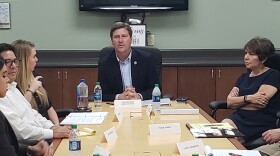The Yuma Sector of the U.S.-Mexico border has four of 11 new projects that will be completed as a result of the diversion of Pentagon funds.
Defense Secretary Mark Esper, who visited the Yuma Proving Ground when he was Secretary of the Army last November, alerted members of the Senate and House Armed Services committees of the plans to proceed with cutting military construction projects to move ahead with building the wall.
The four Yuma projects total about $1.3 billion.
The projects are:
-Yuma Project 2 ($40M): Replacement of one segment of primary pedestrian fencing on the Barry M. Goldwater Range starting 2.5 miles east of Border Monument 198 and extending cast to Border Monument 297. for a total of approximately 1.5-2 miles.
-Yuma Project 10/27 ($527M): Construction of approximately 31 miles of a new secondary pedestrian fence system on the Barry M. Goldwater Range.
-Yuma Project 3 ($630M): Replacement of 31 miles of vehicle barriers with new pedestrian fencing, beginning approximately 0.4 miles east of the Barry M. Goldwater Range and continuing for approximately 3 1 miles east through the Cabeza Prieta National Wildlife Refuge in Yuma County.
-Yuma Project 6 ($65 M): Construction of approximately one mile of a new primary pedestrian fence system starting at Andrade Port of Entry and extending a half mile west of monument marker 206, then resuming east of the Colorado River and extending south one mile and construction of two miles of a new secondary pedestrian fence system starting a half mile east of monument marker 208 and extending east to the Colorado River, and then resuming on the east side of the Colorado River and extending south for approximately one mile.
Republican U.S. Sen. Martha McSally said she fought to ensure no projects in Arizona were impacted. McSally said the lone project impacted in Arizona at Fort Huachuca was already delayed due to unforeseen environmental issues at the construction site.
The fort's Ground Transport Equipment Building project has a cost of about $30 million.
Reactions to the border wall news were split along party lines.
In a released statement, Democratic U.S. Rep. Raul Grijalva said “With this authoritarian power grab and plunder of military accounts, Trump continues with his quest to build his monument to his racist policies along the Southern border. The only national emergency is Trump’s narcissism.”
Congressman Grijalva said he has repeatedly condemned what he said are the unconstitutional actions of the Trump Administration to declare a national emergency to build the border wall and steal money from the Department of Defense to fund it. In April, he said he urged Appropriations Committee Chairwoman Nita Lowey to include language in the Fiscal Year 2020 Department of Defense Appropriations Bill to prohibit the transfer of funds from other military projects to fund border wall construction.
Grijalva said “Trump’s border wall will be a stain on the beautiful landscapes and vibrant cultures that make up the borderlands of Southern Arizona. I will continue working in Congress to vehemently oppose any efforts by Trump to construct his divisive wall that will divide families, recklessly endanger precious desert ecosystems, and militarize border communities.”
Grijalva said border wall construction has already begun in the Organ Pipe National Monument in Southern Arizona and these latest funds will be used to construct walls on military lands—including the Goldwater Range in Rep. Grijalva’s district.
Other border projects announced by Secretary Esper include improvements at the Calexico West Port of Entry, new pedestrian fencing and barriers in San Diego and replacement of vehicle barriers in El Paso.
The 11 projects have an estimated total cost of $3.6 billion.







